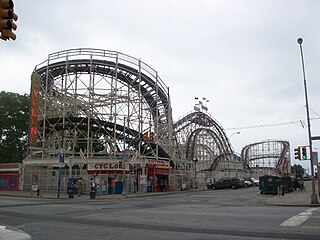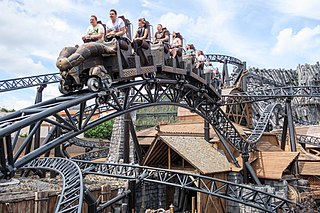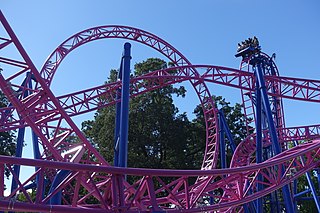
A roller coaster is a type of amusement ride employing a form of elevated railroad track that carries passengers on a train through tight turns, steep slopes, and other elements designed to produce a thrilling experience. Trains consist of open cars connected in a single line, and the rides are often found in theme parks around the world. Roller coasters first appeared in the 17th century, and LaMarcus Adna Thompson obtained one of the first known patents for a roller coaster design in 1885, based on the Switchback Railway which opened a year earlier at Coney Island.

Bobbejaan Schoepen was a Flemish pioneer in Belgian pop music, vaudeville, and European country music. Schoepen was a versatile entertainer, entrepreneur, singer-songwriter, guitarist, comedian, actor, and professional whistler, as well as the founder and former director of the amusement park Bobbejaanland. His musical career flourished from 1948 until the first half of the 1970s. He sold more than five million copies from his repertoire of 482 songs, which extended from Twang, cabaret, instrumental film music, chansons, country, to folk and vocal music. Born in Boom, Antwerp, Flanders, Belgium, he worked his way up from a working-class environment to become one of the 200 richest people in Belgium.
Anton Schwarzkopf was a German engineer who founded Schwarzkopf Industries GmbH, a German manufacturer of roller coasters and other amusement rides that were sold to amusement parks and travelling funfairs around the world.

The launched roller coaster is a modern form of roller coaster. A launched coaster initiates a ride with high amounts of acceleration via one or a series of linear induction motors (LIM), linear synchronous motors (LSM), catapults, tires, chains, or other mechanisms employing hydraulic or pneumatic power, along a launch track. This mode of acceleration powers many of the fastest rollercoasters in the world.

Boomerang is a model of roller coaster manufactured and designed by Vekoma, a Dutch manufacturer. The roller coaster model name is from the hunting implement based on the traditions of the Indigenous Australians. As of January 2023 there are 55 Boomerangs operating.

Phantasialand is a theme park in Brühl, North Rhine-Westphalia, Germany that attracts approximately 2 million visitors annually. It was opened in 1967 by Gottlieb Löffelhardt and Richard Schmidt. Although starting as a family-oriented park, it has added thrill rides, especially in recent years. Following the example of Europa-Park, it has also decided to attract business customers, calling spring the slogan "Business to Pleasure".

An indoor roller coaster or enclosed roller coaster is a roller coaster built inside a structure. The structure may be unrelated to the ride, or it may be intended solely or primarily for the ride. Many indoor coasters are custom made and placed in amusement parks or shopping malls. LaMarcus Adna Thompson, who pioneered the construction of the first simple roller coasters, initially built "scenic railway" rides including "indoor tableaux, panoramas, and biblical scenes illumined by car-tripped switches and flood lamps". A "completely enclosed roller coaster" called the Twister was built as early as 1925. Walt Disney World's Space Mountain was one of the first rides considered to be an indoor roller coaster, and was "the first indoor roller coaster where riders were in total darkness for the length of the ride so they couldn't tell where the drops or turns would occur".


Roller coaster amusement rides have origins back to ice slides constructed in 18th-century Russia. Early technology featured sleds or wheeled carts that were sent down hills of snow reinforced by wooden supports. The technology evolved in the 19th century to feature railroad track using wheeled cars that were securely locked to the track. Newer innovations emerged in the early 20th century with side friction and underfriction technologies to allow for greater speeds and sharper turns. By the mid-to-late 20th century, these elements intensified with the introduction of steel roller coaster designs and the ability to invert riders.

The Illusion is a fully enclosed tubular steel roller coaster, manufactured by Vekoma. It runs on Vekoma's narrow MK-700 track system. Two were built, both in 1989, Chaos in Opryland USA (Tennessee), and Revolution / Mount Mara in Bobbejaanland (Belgium). Only the one in Bobbejaanland is still active.

Mirabilandia is a 210-acre theme park, located in Savio, Italy, a frazione of Ravenna, which is located in Emilia-Romagna. With a total area of 850,000 square metres, it is the biggest park in Italy.
Preston & Barbieri is an amusement ride manufacturing company based in Reggio Emilia, Italy. The company was founded in 2000 as a merger of the Preston and Barbieri Rides companies. The company manufactures a wide range of flat rides, water rides and roller coasters out of its 70,000-square-metre (750,000 sq ft) property in Italy.
James Albert Abraham, known as Jimmy Ross or Mel Turner, was a singer and composer mostly known for his 1981 disco hit in England, "First True Love Affair."
Dreamcatcher is a roller coaster in Bobbejaanland in Belgium. Originally opening in 1987 as Air Race, Dreamcatcher was designed and built by Vekoma. It was Europe's first suspended roller coaster.

Typhoon is a steel roller coaster at the Bobbejaanland amusement park in Lichtaart, Belgium. Typhoon is a Gerstlauer Euro-Fighter model roller coaster, and the second installation of this model line. At 97 degrees, the coaster's first drop is steeper-than-vertical and it has the steepest drop of any roller coaster in Belgium.
Eurofighter is the Eurofighter Typhoon, a model of jet fighter.

Taron is a multilaunch steel roller coaster manufactured by Intamin located at Phantasialand in Germany. It was the fastest multi-launched roller coaster in the world when it opened. Taron opened on 30 June 2016.

Fury is a triple launched roller coaster in the Belgian amusement park Bobbejaanland. It opened on June 24, 2019. It is the 2nd fastest roller coaster inside Benelux with a maximum speed of 106.6 kilometers per hour. Before the ride, passengers can choose with a voting system whether the ride will be done in the forward or backward direction.

Adrenaline Peak is a steel roller coaster at Oaks Amusement Park, just south of Portland, Oregon. The ride replaced the Pinfari Looping Thunder coaster in the park's South End, which closed after the 2017 season. The coaster was manufactured by Gerstlauer and is one of their Euro-Fighter coasters, containing three inversions and a vertical lift hill.

F.L.Y. is a flying launched roller coaster at Phantasialand in Brühl, Germany. The coaster is the sole attraction of the Rookburgh area, a highly themed immersive Steampunk city, which was soft opened in September 2020 following several years of development and construction. During the ride, passengers sit in a prone position - facing the ground - while traversing two launches and navigating a heavily themed environment.




















